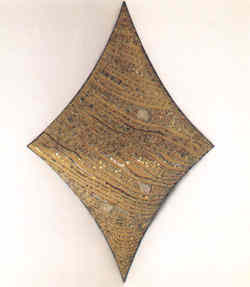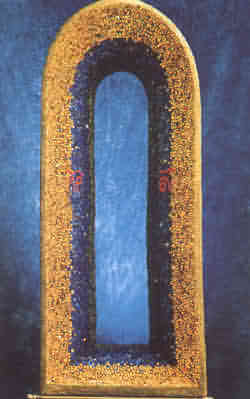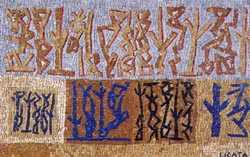
 |

MOSAIC MATTERS MORE AND MORE- TWO HIGHLIGHTS OF 1997By Peter Fischer
If you have been studying mosaics of all ages for more than thirty years, you will have seen countless ancient and mediaeval ones at archaeological sites, in churches and museums on four continents; but you will have difficulty remembering more than a handful of exhibitions of contemporary work, although there can be no doubt that in the long history of the art of mosaic the present period is at least as significant and as good as its great periods of the past. So it was a welcome surprise that there were at least two major exhibitions of modern mosaics in Italy in 1997, followed by the 8th AIEMA Colloquium which, while devoted to classical mosaics, did not ignore the present. In fact it was difficult to fit all this into one individual's itinerary, so no detailed personal account can be given here of the show at the Accademia Belle Arti in Ravenna, which focussed on mosaic in contemporary design, such as mosaic-encrusted tables, chairs, shelves, mirror frames, clocks, lamps and other practical objects. The exhibition in Udine, a provincial capital north of Venice and close to the Austrian and Slovenian borders, seemed to have a very similar scope, judging by its unfortunately ambiguous title: "New Contaminations: Mosaic, Architecture, Art, Design". The connotation with contaminated food made this sound rather ominous, but in fact the accent was very much on Art, and predominantly high standard, clearly contemporary and inventive Art at that. 44 artists, workshops and companies were represented, among them the Ravenna group Akomena around the go-ahead Francesca Fabbri, and the Vicenza mega-firm of Bisazza (which not only produces vitreous tesserae, but creates complete mosaic decorations, and also sponsored this show). There were in this nest some eggs which were past their sell-by date, and could have been done without - indeed the exhibition had grown so large that the lecture hall of the municipal Galleria d'Arte Moderna, which organised it, could not contain it all, not even with the addition of the large space of the former church of San Francesco, so that some of the overflow had to be accommodated in several small galleries around the city, which obviously disrupted the impression of the exhibition as a whole. In fact, it may well have been thelargest show of contemporary mosaics ever presented anywhere, although it was basically limited to a selection of north Italian artists (and even omitted some of the best work produced in that area today). But then Udine is close to the great centres of Venice and Ravenna, and is even closer to the town of Spilimbergo, where the renowned Scuola Mosaicisti del Friuli, with a tradition of 75 years behind it, provides graded 3-year courses of thorough training in the various skills of mosaic-making for artisans, and is now deliberately increasing its endeavour to promote experimental work by aspiring artists as well. So there were important contributions to the Udine exhibition, and indeed some of the best, by Spilimbergo students and teachers, both former and current ones, such as Nane Zavagno, Giulio Candussio, Giovanni Travisanutto (who has worked in America for years) and Lino Linossi (now based in Germany).
The closing date at Udine was just right to use the railway as a time-machine for travelling back into classical antiquity: to Switzerland and the spacious and splendid new campus of the University of Lausanne by the shore of Lake Geneva for the opening of the 1997 Colloquium of the Paris-based Association Internationale pour l'Étude de la Mosaïque Antique (AIEMA, see also p.4). Archaeologists and art historians from two dozen countries (including Russia and the Ukraine for the first time) met for reports on recent discoveries and papers and discussions on iconographic and technical problems. Two of these may be of more general interest, as they concern two of the greatest and most spectacular ensembles of classical mosaics and their notoriously uncertain dates. The large villa at Piazza Armerina in Sicily was originally thought to be a residence of the Emperor Maximianus Herculius, and datable to about 310 AD: but this has been doubted for years. Now a young German archaeologist, Petra Baum-vom Felde, has had the idea of investigating not so much the lively mosaic scenes of figures engaged in hunting, sports and eroticism, but comparing the geometric patterns with those of workshops in Roman Africa which have undoubtedly been connected with Piazza Armerina. And her convincing conclusion is that the likeliest date for the Sicilian villa is around 375/380 AD. Perhaps even more controversial has always been the dating of the equally lively mosaic scenes from the Great Palace of the Byzantine Emperors: pieces of no less than 1872 square metres in all, and now attractively displayed in their own museum close to the Blue Mosque in Istanbul. Proposed dates have differed by as much as several hundred years. Now the leading figure in this 15-year project, Werner Jobst of the Austrian Academy of Sciences, has looked for evidence in the foundation layers under the mosaics, and has found fragments of amphorae from Gaza which he dates to 485/500 AD, or not much later. Although there was some dispute in Lausanne about those amphorae, the dating of these magnificent Constantinopolitan mosaics seems to have reached as firm a foundation as it is ever likely to get. Just before the Austrian archaeologist spoke, the only living mosaicist at the conference, Irene Rousseau from America, used the microphone to talk passionately and persuasively about mosaic as art, and about her own imaginative work. Samples of it were on view in a nearby hall and, later, in a Lausanne gallery. This was the first time at an AIEMA conference that modern mosaic had appeared on the programme among its ancient predecessors. Is it too much to hope that even modern mosaics are beginning to matter?
|
All
content is copyright of © Mosaic Matters and its contributors.
All rights reserved
Mosaic
Matters is:
Editor: Paul Bentley
Web Manager/Designer: Andy Mitchell



